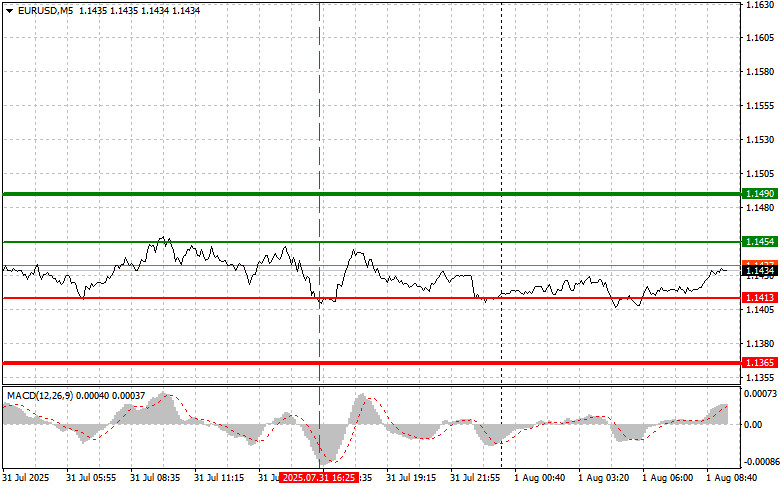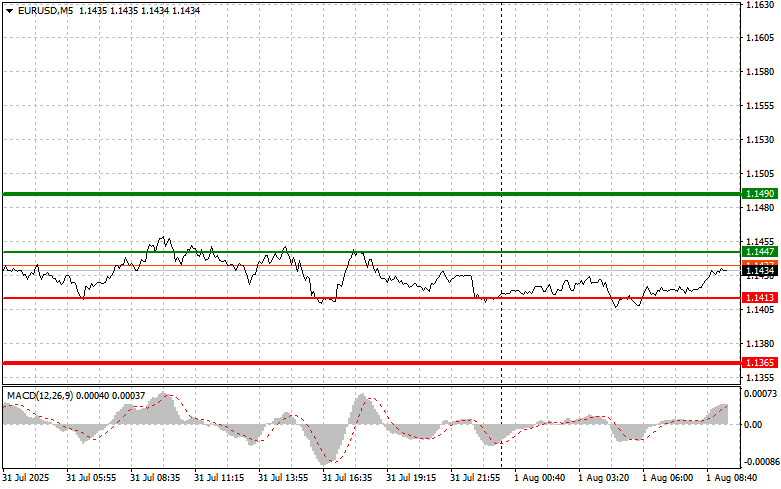Analysis of Trades and Trading Tips for the Euro
The test of the 1.1413 level coincided with the MACD indicator having already moved significantly below the zero line, which limited the pair's downside potential. For this reason, I did not sell the euro.
Data showing growth in the core Personal Consumption Expenditures (PCE) index led to a rise in the U.S. dollar. Investors interpreted this data as a sign of the strength of the U.S. economy, which reduced expectations of imminent monetary policy easing by the Federal Reserve. The increase in the PCE index, a key inflation gauge for the Fed, heightened concerns about persistent inflationary pressures. In turn, this reinforced the view that the Fed may keep interest rates elevated for longer than previously anticipated. This aligns with what the Fed Chair stated following Wednesday's FOMC meeting.
Today will bring the release of the eurozone manufacturing PMI and consumer price indices, including the core CPI. These reports are crucial for understanding the current state of the European economy and may influence future monetary policy decisions by the European Central Bank. The PMI, or Purchasing Managers' Index, is an indicator of manufacturing sector conditions. A value below 50 is expected, which would signal a contraction in activity and may weaken the euro. Consumer price indices also carry significant weight. The headline CPI reflects changes in prices across a broad range of goods and services, while the core CPI—excluding volatile items such as food and energy—offers a clearer view of inflation pressures. A rise in CPI may force the ECB to tighten monetary policy, which could, in turn, slow economic growth.
For intraday strategy, I will focus primarily on Scenarios #1 and #2.
Buy Scenario
Scenario #1: I plan to buy the euro today upon reaching the 1.1446 level (green line on the chart), targeting a rise toward 1.1490. At 1.1490, I intend to exit the market and initiate a short position, aiming for a reversal move of 30–35 pips from the entry level. Buying the euro is only viable in the case of strong data.
Important! Before buying, ensure the MACD indicator is above the zero line and starting to rise from it.
Scenario #2: I also plan to buy the euro if there are two consecutive tests of the 1.1413 level while the MACD is in the oversold zone. This would limit the downside potential and lead to an upward reversal. A rise toward the opposite levels of 1.1449 and 1.1490 can be expected.
Sell Scenario
Scenario #1: I plan to sell the euro after reaching the 1.1413 level (red line on the chart). The target is 1.1365, where I plan to exit the market and initiate a long position in the opposite direction, expecting a 20–25 pip move from that level. Selling pressure may return to the pair at any moment today.
Important! Before selling, ensure that the MACD indicator is below the zero line and just beginning to decline from it.
Scenario #2: I also plan to sell the euro if there are two consecutive tests of the 1.1446 level while the MACD is in the overbought zone. This would limit the pair's upside potential and lead to a downward market reversal. A decline toward the opposite levels of 1.1413 and 1.1365 can be expected.
What's on the Chart:
- The thin green line represents the entry price where the trading instrument can be bought.
- The thick green line indicates the expected price level where a Take Profit order can be placed, or profits can be manually secured, as further price growth above this level is unlikely.
- The thin red line represents the entry price where the trading instrument can be sold.
- The thick red line indicates the expected price level where a Take Profit order can be placed, or profits can be manually secured, as further price decline below this level is unlikely.
- The MACD indicator should be used to assess overbought and oversold zones when entering the market.
Important Notes:
- Beginner Forex traders should exercise extreme caution when making market entry decisions. It is advisable to stay out of the market before the release of important fundamental reports to avoid exposure to sharp price fluctuations. If you choose to trade during news releases, always use stop-loss orders to minimize potential losses. Trading without stop-loss orders can quickly wipe out your entire deposit, especially if you neglect money management principles and trade with high volumes.
- Remember, successful trading requires a well-defined trading plan, similar to the one outlined above. Making impulsive trading decisions based on the current market situation is a losing strategy for intraday traders.













